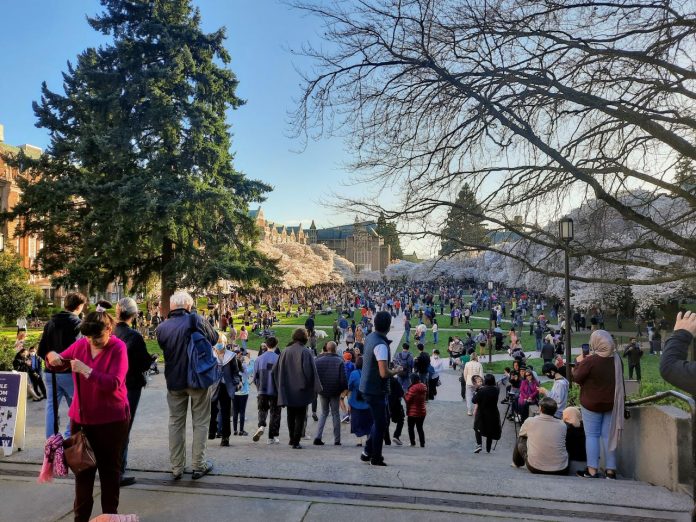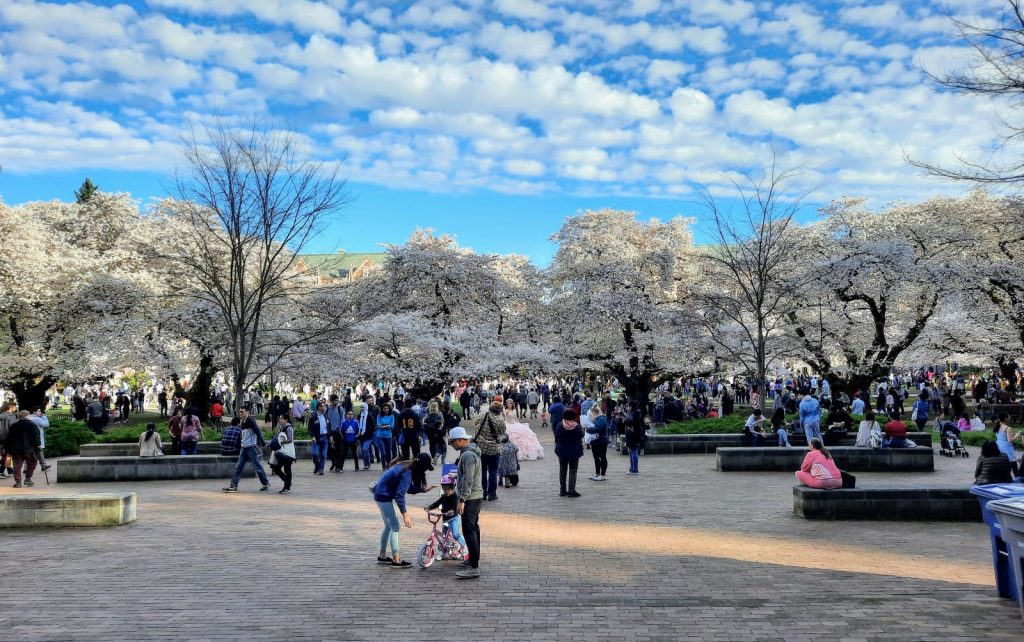
Cars exist in two planes. One plane of existence is the sales pitch: a rugged luxury SUV plowing through a large puddle and offroading through a somehow empty park of pristine valleys and majestic mountains. Then there’s reality: cars in close proximity to thousands of other cars, generating traffic jams, planet-threatening pollution, and no shortage of grouchy passengers. That’s been the reality on full display during recent weekends with the arrival of cherry blossom season.
Buses were operating nearly an hour behind schedule through the University of Washington last weekend as motorists descended in mass on the campus to see cherry blossoms in bloom. While the traffic jam snarled traffic, agencies and officials were slow to react to encourage people to take transit or bike to campus in order to alleviate the situation.
On Friday, the Seattle Department of Transportation (SDOT) gave it the old college try with a few tweets and a blogpost encouraging people to walk, bike, or bus to campus instead of drive. However, without broader support from other agencies and leading officials, the messaging campaign appears too weak and scattered to have had a major impact. As far as The Urbanist can ascertain, no elected officials have amplified that message online, nor has King County Metro or the University of Washington, oddly enough. UW promoted the U District Cherry Blossom Festival, but didn’t emphasize transit. Event promoters did put a plug in for light rail, but did not emphasize bus options, disregarding many would be transit users.
Not surprisingly, U District locals were already reporting another traffic jam and expect for trend to continue throughout the weekend. The cherry blossoms are just too enticing, and transit is not a viable enough option or practiced enough habit for many visitors.
SDOT’s Ethan Bancroft pointed to some upgrades on the horizon, but neither appear sufficient enough to fundamentally alter the congested, car-first reality.
“We are currently working on upgrading traffic signals and installing new traffic cameras in the area (known as an “Intelligent Transportation System”), which will help the streets in the area be more responsive to traffic flow and help with congestion,” Bancroft wrote. Another benefit of this upgraded system is that we’ll be able to remotely operate the signals and adjust their timing in real time, as needed. Construction on these signal upgrades began last fall, and we expect to complete work this spring. We will also be installing new eastbound bus lanes on NE 45th St to improve transit reliability for the Route 44 bus.”
The Route 44 upgrade only includes bus lanes in a few select locations, which means the bus is still likely to get trapped in private vehicle traffic — especially without traffic cameras to keep motorists from infringing on the brief bus lanes. Rollout of SDOT’s automatic traffic camera enforcement pilot has been glacial and limited to the downtown core and Spokane Street bridge thus far.
That small-scale, disjointed effort to promote transit has to compete with massive campaigns to promote car use that blanket the airwaves in billions of dollars in ads. They created the false reality around cars imagining empty wilderness motocross joy rides instead of sitting to bumper-to-bumper traffic on Montlake Boulevard because 10,000 people wanted to the same selfie at the same moment and hopped in a two-ton personal vehicle to get there. How many motorists actually dabble in motocross? And yet every ad looks like this:
Car ads are almost a parody of themselves. Freedom is emphasized to such a degree that a viewer almost can feel it’s too good to be true. Except it works. Especially when the industry is so little regulated and alternatives like transit and biking are funded and promoted so little.
What makes UW such a great place to see cherry blossoms — which are fairly ubiquitous across the region — is the pedestrianized campus so people can relax and take in nature’s art installation uninterrupted by the noise and danger of cars. Ironically, this causes thousands to flood the neighborhood with their cars to get in on the action. We can avoid this irony if we try.

For the next cherry blossom season, what if officials made a concerted effort to promote transit and discourage driving to popular sites to partake in sakura revelry? What if we advertised transit half as much as cars? What if we beefed up bus and light rail service and added more transit priority so getting there was quicker? What if we restricted access to Stevens Way through campus so buses could whisk people through instead of serving as an extended parking lot? And zooming out a bit — what if our society were just more honest about the fact that cars don’t automatically equate to freedom and independence and more often entail being in a jam?
In future years, the cherry blossom crowds might not need to be accompanied by traffic gridlock if we plan better and take proactive steps to encourage transportation alternatives. Insanity is repeating the same experiment over and over and expecting a different result. Let’s work to break free of the vice grip that car insanity holds over us.
Doug Trumm is publisher of The Urbanist. An Urbanist writer since 2015, he dreams of pedestrian streets, bus lanes, and a mass-timber building spree to end our housing crisis. He graduated from the Evans School of Public Policy and Governance at the University of Washington in 2019. He lives in Seattle's Fremont neighborhood and loves to explore the city by foot and by bike.


